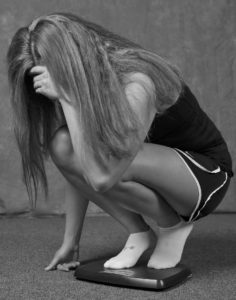- Calls to this hotline are currently being directed to Within Health, Fay or Eating Disorder Solutions
- Representatives are standing by 24/7 to help answer your questions
- All calls are confidential and HIPAA compliant
- There is no obligation or cost to call
- Eating Disorder Hope does not receive any commissions or fees dependent upon which provider you select
- Additional treatment providers are located on our directory or samhsa.gov
Weighing In: The Scale in Eating Disorder Recovery

“Let’s check your weight this week.” That is a bullet sentence right there when you are working with a client who has an eating disorder.
Most clients dread this part of the session when working through their eating disorder symptoms.
Eating disorders are often about weight-shaming in the person’s head. If the person has gained weight, they have ‘failed’ their eating disorder. If they have stayed the same weight from the week before, then they are ‘ok’ but possibly ‘not good enough.’
If they have lost, then it’s a victory, but still it’s never enough for the sufferer.
Scales are for Fish: Letting Go of the Scale
Scales truly belong on fish. Scales create a number displayed on a piece of metal or plastic that holds you to the earth. It’s your gravity. A scale, the electronic piece that is inside it, tells you nothing of your life. It cannot tell you if you have had children or not, loved and lost, or how tall you are. It cannot predict the future or past. It is just a number.
Many clients will say that ‘it’s just a number’ to the clinician, but it is everything to them. The number never lies, it’s black-and-white, and it’s always available to the person struggling with an eating disorder. Many patients will weigh himself daily, multiple times a day. It becomes an obsession and a game.

Often, clinicians will hear that the client will try to see how much weight they can lose in a day, or two days, or a week. It can become a contest with other sufferers to see who can keep their weight the lowest. It’s an obsession with scales within our society.
While letting go of the scale can be an important part of eating disorder recovery, weekly weigh-ins during the early stages of eating disorder treatment are important for the clinician and nutritionist working with the client. They give the treatment team, insurance company, and client a guide of where they are in weight restoration.
True that numbers never lie, but information can lie in the numbers themselves.
Indicators of binge and purge cycles or extreme behaviors can be noticed in patterns of weekly weigh-ins.
It can help within treatment of family-based treatment to see if the therapeutic protocol for refeeding their child is working. It helps the treatment team know when you have reached your weight range target.
Using Scales in Art Therapy for Eating Disorder Recovery
Scales are also used in experiential therapy. Often, scales are smashed, crushed, broken, taken apart and put back together into beautiful pieces of art.
At Saint Louis Behavioral Institute, the intensive outpatient program (IOP) for eating disorders has a beautiful traveling art exhibit called “Scales are for Fish,” where prior IOP members put their scales on display at various high schools and universities around the St. Louis area to show that scales are many things [1].
Expressive arts or creative art therapy is a type of therapy that uses various mediums to help clients express their emotions, thoughts, and experiences [2]. During art therapy, the clinician will aid the client in using music, dance movement, art, drama, storytelling or writing to facilitate recovery, quality of life, and address treatment goals [2]. Art therapy can have a powerful effect on a person, allowing them self-expression in different ways than traditional therapy.
When Scales Can Support Treatment Efforts
Using weight targets as a part of the treatment process can help a clinician and treatment team identify whether a person’s body composition and physical health has been compromised by the eating disorder [3]. From this information, the treatment team can set realistic and reachable goals for the client to be able to restore weight, weight management, and gain healthy weight.
When a person is struggling with anorexia nervosa and low weight or malnutrition, the body will lose muscle and fat stores and deplete from vital organs, bone, and tissues to cope with malnutrition. In bulimia nervosa, the body will be affected by the inconsistency of feeding and purging, and it can affect both a person’s metabolism and growth [3].

Weight checks are also extremely important in children and youth who are struggling with extreme low weights and are tube fed, and stats are vital to success of the feedings. NG tube feeding can be used with oral feeding when weight restoring or gaining medical stability [4].
Tubing can assist in a person’s motivation for treatment, as well as psychological recovery. With anorexia can come severe malnutrition and low body weight. It can lead to heart issues, such as cardiac failure and arrhythmia, as well as cognitive deficiencies and an inability of the patient to understand how severe the eating disorder is.
Being able to use a tube in refeeding and getting a weight check daily or every other day to determine medical stability is a critical part of the initial goal in eating disorder recovery for many individuals with severe malnutrition [4].
Open Weighing and Weight Management
Open weighing is when you see your weight during weekly or other segmented weigh-ins [5]. This is typically done with your nutritionist or clinician, and the weight is charted on a weight graph or timeline. It can be used to help with treatment goals with the client.
There several are therapies that use weighing as part of the treatment approach. One is cognitive behavioral therapy (CBT) and a second is family-based treatment (FBT), or the Maudsley Model. The second therapy uses weight to track progress in the first phase of treatment.
CBT uses weight to set further goals, such as weight loss or maintenance, and weight gain or stabilization. It can also help set further behavior goals, as well as attack negative thinking during the therapy process.
Weighing helps work through uncomfortable emotions and learn to ‘sit’ with these emotions in the therapeutic setting. It can allow for mindfulness in the moment, and let the client be aware that they can feel several emotions at one time and manage them in a healthy way.
To summarize, using a scale in an eating disorder treatment seeing can be extremely beneficial for both the client and clinician. It offers opportunities for discussion around negative thinking, new emotions, and setting goals. It can also help the sufferer learn to let go of the scale and begin to adapt to the feelings and sensations in their body, rather than the number on the scale.
 About the Author: Libby Lyons is a Licensed Clinical Social Worker and Certified Eating Disorder Specialist (CEDS). Libby has been practicing in the field of eating disorders, addictions, depression, anxiety and other comorbid issues in various agencies. Libby has previously worked as a contractor for the United States Air Force Domestic Violence Program, Saint Louis University Student Health and Counseling, Saint Louis Behavioral Medicine Institute Eating Disorders Program, and has been in Private Practice.
About the Author: Libby Lyons is a Licensed Clinical Social Worker and Certified Eating Disorder Specialist (CEDS). Libby has been practicing in the field of eating disorders, addictions, depression, anxiety and other comorbid issues in various agencies. Libby has previously worked as a contractor for the United States Air Force Domestic Violence Program, Saint Louis University Student Health and Counseling, Saint Louis Behavioral Medicine Institute Eating Disorders Program, and has been in Private Practice.
Libby currently works as a counselor at Fontbonne University and is a Adjunct Professor at Saint Louis University, and is a contributing author for Addiction Hope and Eating Disorder Hope. Libby lives in the St. Louis area with her husband and two daughters. She enjoys spending time with her family, running, and watching movies.
References:
[1] Eating Disorder Treatment Center in St Louis MO. (n.d.). Retrieved June 11, 2017, from http://www.slbmi.com/eating-disorders[2] Expressive Arts Therapy and Eating Disorders. (2015, January 15). Retrieved June 11, 2017, from https://www.nationaleatingdisorders.org/blog/expressive-arts-therapy-and-eating-disorders
[3] Review the Patient’s Growth History. (n.d.). Retrieved June 11, 2017, from http://www.feast-ed.org/?page=SettingTargetWeight
[4] Nasogastric (NG) Tube Feeding and Anorexia Nervosa: Why and When? (2015, December 01). Retrieved June 11, 2017, from https://www.edcatalogue.com/nasogastric-ng-tube-feeding-and-anorexia-nervosa-why-and-when/
[5] The Importance of SEEING your Weight in Eating Disorder Treatment. (n.d.). Retrieved June 11, 2017, from http://www.louisvilleeatlab.com/blog–in-the-press/the-importance-of-seeing-your-weight-in-eating-disorder-treatment
The opinions and views of our guest contributors are shared to provide a broad perspective of eating disorders. These are not necessarily the views of Eating Disorder Hope, but an effort to offer discussion of various issues by different concerned individuals.
We at Eating Disorder Hope understand that eating disorders result from a combination of environmental and genetic factors. If you or a loved one are suffering from an eating disorder, please know that there is hope for you, and seek immediate professional help.
Published on August 16, 2017.
Reviewed By: Jacquelyn Ekern, MS, LPC on August 16, 2017.
Published on EatingDisorderHope.com

The EatingDisorderHope.com editorial team comprises experienced writers, editors, and medical reviewers specializing in eating disorders, treatment, and mental and behavioral health.

